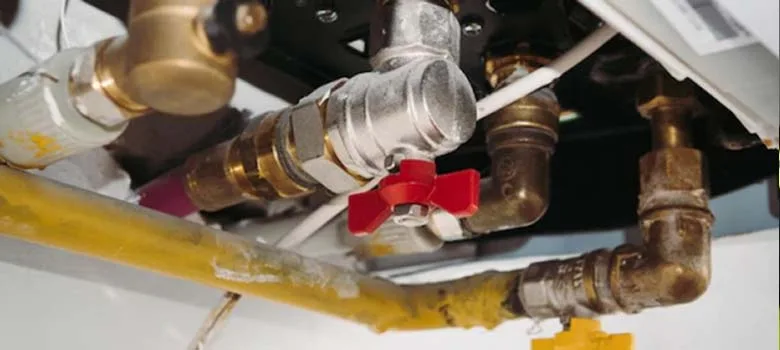When it comes to creating connections, using the right gas fittings is imperative in the plumbing realm for a safe and secure job.
Gas fitting is a specialised kind of plumbing that requires a certain level of training and certification. One of the reasons that so much education is required is the sheer number of different gas fitting types there are. No two fittings are exactly the same when it comes to installing or repairing gas lines or creating the right connection between a line and an appliance.
A gas fitter is a plumbing specialist who should have the knowledge needed for a job done right. They’ll also understand the different types of gas fittings and when (and where) they are best used. It’s important to keep in mind that while understanding these different fitting types can be helpful to your conversations with a plumber or gas fitter, you will want to leave the work to the professionals. In fact, it’s illegal to try to perform your own gas fitting work.
Wondering whether your gas fittings are leaking? Check out our dedicated blog.
Types of gas fittings by function
One reason why there are so many different types of gas fittings is that they are designed for specific functions. Some need to be able to change the direction of a pipe, while others create a connection between two different-sized pipes. Moreso, there are gas fittings specifically shaped to extend or end tube lengths. It all depends on what you are trying to achieve with the work being done on your lines and appliances.
Here are some of the most common gas fittings by function and where or when you would expect them to be used.
- Adapter: Connect two different-sized pipes based on the diameter
- Coupling: Connect two pipes of the same size or diameter
- Sleeve: Connect two pipes of the same size without welding
- Union: Connect with an easy disconnect without cutting
- Cap: Closes off the end of a length of pipe via a male end
- Plug: Closes off the end of a length of pipe via a female end
- Elbow: Change direction typically in 90- or 45-degree angles
- Tee: Connect three pieces of tubing to combine or split the flow
- Wye: Connect three pieces of tubing in a Y-shape intersection
- Cross: Connect four pieces of tubing
- Reducer: Connect two different-sized tubes
- Valve: Connect tubes with flow control
- Nipple: Connect two tubes with both ends featuring male connections
The right gas fitting can be chosen based on two main features: size and operation.
Most gas fittings are designed to create connections between different lengths or directions of pipe or tubing, but not all tubes are created equal when it comes to size or material. Gas fittings help professionals literally fit together the different tubes to create a singular flow between the source of the natural gas and the appliance powered by it.
Operation is more than just whether or not you need a valve to operate the flow of natural gas. It’s a measure of how much pressure and temperature the fitting is designed to operate under or withstand. Different fittings come with different ratings, which a professional will reference in order to use the right type.
Types of gas fittings by connection
How the connections are actually made between the fittings and/or the fitting and the pipe are also a factor in choosing the best type for your job. Consider that there are a number of different tube fittings based on the connection type and how they create a seal that can be relied on.
- Compression fittings make a connection and seal by placing pressure on a gasket, ring, or ferrule.
- Mechanical fittings leverage two ferrule grips that press into each other and create a seal.
- Bite-type fittings use ferrules that dig into the pipe and create a natural compression seal.
- Flange fittings are connected to pipes by using clamps or welding.
- Flare fittings handle high pressure by creating a seal inside the tube with a flared end.
- Threaded fittings use grooves to accept matching threads, including female and male surfaces.
Types of gas fittings by material
Not only do gas fittings come in different shapes and configurations, as outlined above, but they also come in a variety of materials depending on the needs of the job. While the cost of materials can be one deciding factor, the choice of material usually comes down to the function of the pipe and the operation ratings for temperature and pressure. Different materials are designed to withstand different levels, all of which play an important part in choosing the right fitting made of the right stuff. Here are some examples of material types you can find gas fittings available in:
- Aluminium
- Brass
- Cast iron
- Copper
- Nylon
- Polyethylene
- PVC
- Steel
- Stainless steel
How to choose the best gas fitter for the job
Clearly, gas fittings are just one aspect of the installation and repair of a gas line and connections, yet they remain complex and varied depending on a number of features. This makes choosing a knowledgeable and dependable gas fitter even more important for home and business owners with gas fitting needs.
Read on: How Much Do Gas Fitters Cost on the Sunshine Coast?
To choose the best gas fitter on the Sunshine Coast, you’ll want to look at their range of experience and level of licensure and certification. Look for individuals or businesses that place an emphasis on communication and quality. You’ll want to be informed about the decisions being made and the solutions that are going to be implemented, even if you can’t partake in the work yourself.
What’s more, you’ll also want to work with a local Sunshine Coast gas fitter with a solid reputation. You can research this in a few different ways, from asking for customer testimonials directly from the provider to taking them to the internet in search of feedback. Past customers should be willing to speak about their experience with the gas fitter and plumber of your choice, and their feedback should be positive when it comes to everything from practical work to customer service.
Call on DYFA Plumbing for your gas fitting needs
At DYFA, we understand the complexity and requirements of gas fitting. That’s why we employ specialised gas fitters who can take on projects of all shapes and sizes in both residential and commercial instances. We place an emphasis on communication throughout every job, keeping you informed of how long we expect to take and what is involved with your particular request. We want every customer to be confident that their choice to work with us will result in quality, honest work that’s reliable and thorough.
For your gas fitting needs, call the team at DYFA Plumbing on 07 5475 4152 today. We can provide you with a fast and free quote for your installation or repair project.




